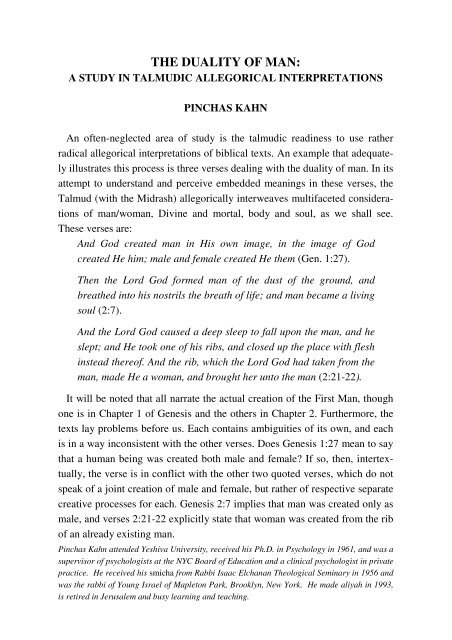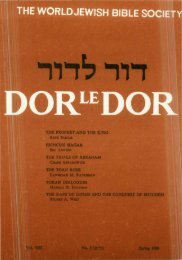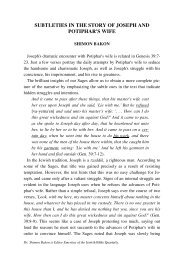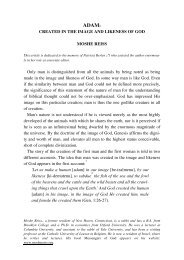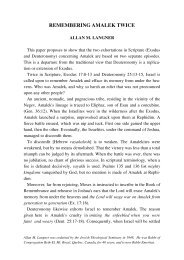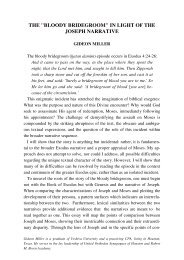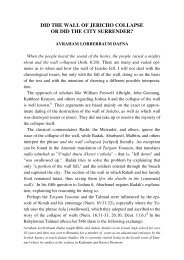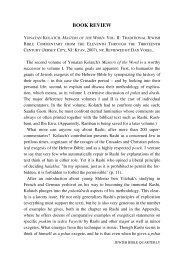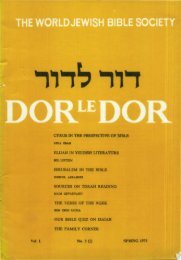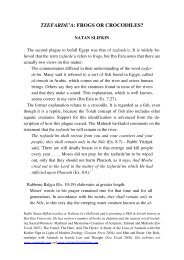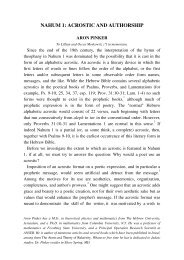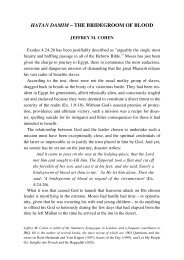THE DUALITY OF MAN: - Jewish Bible Quarterly
THE DUALITY OF MAN: - Jewish Bible Quarterly
THE DUALITY OF MAN: - Jewish Bible Quarterly
You also want an ePaper? Increase the reach of your titles
YUMPU automatically turns print PDFs into web optimized ePapers that Google loves.
<strong>THE</strong> <strong>DUALITY</strong> <strong>OF</strong> <strong>MAN</strong>:<br />
A STUDY IN TALMUDIC ALLEGORICAL INTERPRETATIONS<br />
PINCHAS KAHN<br />
An often-neglected area of study is the talmudic readiness to use rather<br />
radical allegorical interpretations of biblical texts. An example that adequately<br />
illustrates this process is three verses dealing with the duality of man. In its<br />
attempt to understand and perceive embedded meanings in these verses, the<br />
Talmud (with the Midrash) allegorically interweaves multifaceted considerations<br />
of man/woman, Divine and mortal, body and soul, as we shall see.<br />
These verses are:<br />
And God created man in His own image, in the image of God<br />
created He him; male and female created He them (Gen. 1:27).<br />
Then the Lord God formed man of the dust of the ground, and<br />
breathed into his nostrils the breath of life; and man became a living<br />
soul (2:7).<br />
And the Lord God caused a deep sleep to fall upon the man, and he<br />
slept; and He took one of his ribs, and closed up the place with flesh<br />
instead thereof. And the rib, which the Lord God had taken from the<br />
man, made He a woman, and brought her unto the man (2:21-22).<br />
It will be noted that all narrate the actual creation of the First Man, though<br />
one is in Chapter 1 of Genesis and the others in Chapter 2. Furthermore, the<br />
texts lay problems before us. Each contains ambiguities of its own, and each<br />
is in a way inconsistent with the other verses. Does Genesis 1:27 mean to say<br />
that a human being was created both male and female? If so, then, intertextually,<br />
the verse is in conflict with the other two quoted verses, which do not<br />
speak of a joint creation of male and female, but rather of respective separate<br />
creative processes for each. Genesis 2:7 implies that man was created only as<br />
male, and verses 2:21-22 explicitly state that woman was created from the rib<br />
of an already existing man.<br />
Pinchas Kahn attended Yeshiva University, received his Ph.D. in Psychology in 1961, and was a<br />
supervisor of psychologists at the NYC Board of Education and a clinical psychologist in private<br />
practice. He received his smicha from Rabbi Isaac Elchanan Theological Seminary in 1956 and<br />
was the rabbi of Young Israel of Mapleton Park, Brooklyn, New York. He made aliyah in 1993,<br />
is retired in Jerusalem and busy learning and teaching.
<strong>THE</strong> <strong>DUALITY</strong> <strong>OF</strong> <strong>MAN</strong><br />
The Talmud uses these verses from Genesis in a discussion centered upon<br />
understanding Psalm 139:5, in itself an example of ambiguous duality. The<br />
Psalm begins with a description of an omniscient God who examines and<br />
knows man completely. Then, in verse 5, it states: Thou hast hemmed me in<br />
behind and before, and laid Thy hand upon me. Ostensibly, this verse has no<br />
connection with the creation of man. Nevertheless, with this verse, the Babylonian<br />
Talmud (Brachot 61a-61b) begins a lengthy discussion on man's duality<br />
by referring to the verses in Genesis. R. Jeremiah b. Eleazar said: "God<br />
created two countenances in the first man [italics mine], as it says, Behind<br />
and before hast Thou formed me [a rephrasing of Ps. 139:5]." 1<br />
The reference to the "two countenances in the first man" is an evident allusion<br />
to Genesis 1:27: . . . male and female created He them. The introductory<br />
reference to Psalm 139:5 appears to obviate the possibility that Genesis 1:27<br />
be understood as referring to man in general as if in the same category as<br />
other animals, male and female (as in Gen. 6:19). If "male and female" in<br />
Genesis does not mean two separate beings, what then does it mean?<br />
The Talmud perceives the necessity of an allegorical interpretation to understand<br />
"male and female" and finds it embedded in the phrase "behind and<br />
before" of Psalm 139:5. Thus, the Talmud initially interprets "the first man"<br />
as being created with "two countenances."<br />
Joseph B. Soloveitchik 2<br />
pushes R. Jeremiah's dictum further. He proposes<br />
that the verse is not referring to the physiology of man, but conceptually to<br />
the "image of God" in man. The phrase “male and female” is to be understood<br />
not physically, but as representing abstract psychological tendencies;<br />
namely, passive and active. The "two countenances" describe two poles of<br />
human behavior that are found in all mankind, male and female alike. Soloveitchik's<br />
conception is implied in the talmudic allegorization of Genesis and<br />
Psalm 139.<br />
Soloveitchik delves even further: he understands these traits not only as<br />
psychological categories, but also as having religious and philosophical aspects<br />
as well. In a later work, on the basis of <strong>Jewish</strong> mysticism, he develops<br />
this dual aspect of being into transcendental proportions:<br />
The principles of creativity and receptivity, acting and being acted<br />
upon, energizing and absorbing, aggressiveness and toleration, initiating<br />
and completing, of limitless emanation of a transcendental<br />
Vol. 36, No. 2, 2008<br />
103
104<br />
PINCHAS<br />
KAHN<br />
being and measured reflection of the cosmos, are portrayed by the<br />
dual motif of masculinity and femininity within our religious experience.<br />
. . . Unconditioned, creative, infinite transcendence and selfconditioned,<br />
receptive finite immanence of God are symbolized by<br />
masculinity and femininity. 3<br />
God's creation of male and female is thereby understood allegorically, and<br />
the "two countenances" explain man as dualistically passive and active, receptive<br />
and creative, reflecting his experience of God as transcendent and<br />
immanent.<br />
The Talmud then proceeds with a different allegorical approach, regarding<br />
Genesis 2:21-22, the apparent creation of woman: And the rib which the Lord<br />
God had taken from man made he a woman. Rav and Samuel explained this<br />
differently. One said that [the rib] was a face, the other that it was a tail. No<br />
objection can be raised against the one who says it was a face, since so it is<br />
written, Behind and before hast Thou formed me. But how does he who says<br />
it was a tail explain Behind and before hast Thou formed me? As stated by R.<br />
Ammi:<br />
. . . for R. Ammi said: "'Behind' [that is, last] in the work of creation,<br />
and 'before' [that is, first] for punishment. We grant you he was last<br />
in the work of creation, for he was not created till the eve of Sabbath.<br />
But when you say 'first for punishment,' to what punishment<br />
do you refer?<br />
. . . . [After rejecting the possibility that the first punishment was<br />
Adam/Eve's expulsion from Eden, the Talmud proceeds:] I must say<br />
then that the punishment of the Flood is meant, as it is written, And<br />
He blotted out every living substance which was upon the face of<br />
the ground, both man and cattle" (Berachot 61a-61b).<br />
Allegorical interpretation is now applied to the "rib" itself. The "rib"<br />
represents a face and/or tail, indicating that man is both the first in creation<br />
and the last in creation. Man as the first in creation indicates a level of significance.<br />
Being the last in creation may suggest that he is actually the goal of<br />
the creative developmental process. On the other hand, being the last may<br />
indicate nevertheless a lack of significance as compared to the overall grandeur<br />
of creation. In any case, the last part of the talmudic exposition regard-<br />
JEWISH BIBLE QUARTERLY
<strong>THE</strong> <strong>DUALITY</strong> <strong>OF</strong> <strong>MAN</strong><br />
ing punishment preserves the concept of man/woman as a duality somehow<br />
singular.<br />
By introducing the concept of first and last of punishment, the Talmud introduces<br />
moral choice as distinctly generic man's, thereby burdened with accountability.<br />
Clearly, man must be worthy, because he is accountable. An<br />
elaboration of this is seen in midrashic literature:<br />
And God said: let us make man , . . . (Gen. 1:26). R. Johanan commenced<br />
[his discourse]: "Thou hast formed me behind and before, . .<br />
." (Ps.139:5). Said R. Johanan: "If a man is worthy enough, he enjoys<br />
both worlds, for it says, 'Thou hast formed me for a later<br />
[world] and an earlier [world].' But if not, he will have to render a<br />
full account [of his misdeeds], as it is said, And laid Thy hand upon<br />
me" (ibid.) (Midrash Rabbah Gen. 8:1).<br />
The accountability of man focuses on both the creation of man as male and<br />
female as well as on the procedure with the rib. This suggests that the creation<br />
of male and female, the creation of "woman" from the "rib," and the elaboration<br />
in Psalm 139 of "behind and before" are understood as one thematic<br />
axis.<br />
This accountability is not limited to individual man, but to man in general.<br />
Midrash Rabbah continues:<br />
R. Joshua b. R. Nehemiah and R. Judah b. R. Simon in R. Eleazar's<br />
name said: "He created him filling the whole world. How do we<br />
know [that he stretched] from east to west? Because it is said, Thou<br />
hast formed me behind [ahor] and before [kedem]."<br />
Man is responsible not only for himself, but for the entire world.<br />
A further rabbinic elaboration of the basic theme of the duality of man<br />
perceives his being of both heaven and earth.<br />
R. Tifdai said in R. Aha's name: "The Holy One, blessed be He,<br />
said: 'If I create him of the celestial elements he will live [for ever]<br />
and not die, and if I create him of the terrestrial elements, he will die<br />
and not live [in a future life]. Therefore I will create him of the upper<br />
and of the lower elements: if he sins he will die; while if he does<br />
not sin, he will live'" (Midrash Rabbah – Gen. 14:3).<br />
Vol. 36, No. 2, 2008<br />
105
106<br />
PINCHAS<br />
KAHN<br />
As David the psalmist cries to the Creator: What is man that You<br />
are mindful of him, / mortal man that you have taken note of him, /<br />
that You have made him a little lower than the angels (Ps. 8:4).<br />
As noted, "Rab and Samuel explained this [the rib] differently. One said that<br />
[it] was a face, the other that it was a tail" allegorically implying that man is<br />
to be viewed as both animal and human. Rabbi Abbahu goes even further:<br />
R. Abbahu contrasted two texts. It is written, Male and female<br />
created He them, and it is also written, For in the image of God<br />
made He man. How are these statements to be reconciled? At first<br />
the intention was to create two, but in the end only one was created<br />
(Berachot 61a).<br />
Man is not just of this world, but created in the image of God. The image of<br />
God within represents man's intellectual and cognitive being, as Soloveitchik<br />
asserted, a creature aware of his existence, cognizant of moral implications<br />
and able to choose. As one entity, he resembles his Creator, only "a little<br />
lower than the angels"; as a dual entity, he resembles all other earthly creatures,<br />
created separately male and female. In the Midrash:<br />
R. Simeon b. Lakish maintained: "He [man] was the latest in the<br />
work of the last day and the earliest in the work of the first day."<br />
That is consistent with the view of R. Simeon b. Lakish, for he said:<br />
"And the spirit of God hovered (Gen. 1:2) refers to the soul of<br />
Adam, as you read, And the spirit of the Lord shall rest upon him<br />
(Isa. 40:7)" (Midrash Rabbah - Genesis 7:2).<br />
Amazingly, R. Simeon b. Lakish allegorizes the spirit of God hovered over<br />
the face of the waters in Genesis 1:2 as referring to the soul of man! The<br />
duality of man is radical indeed, human/animal, man/angel, human/godly,<br />
creature/creator.<br />
To summarize, man's uniqueness is seen in his duality. Both human and<br />
godly, man is part of the creative process of the natural world, and at the<br />
same time recipient of the image of God. It is his duality that is expressed in<br />
the various descriptions of his creation and is ultimately the expression of his<br />
uniqueness. His uniqueness is manifested in his intellectual and cognitive<br />
abilities as well as his self-awareness and his ability to choose and to create<br />
to the limits of his earthly ability. As part and parcel of the natural process,<br />
an animal driven by needs and subject to brute lack of sensitivity, he may<br />
JEWISH BIBLE QUARTERLY
<strong>THE</strong> <strong>DUALITY</strong> <strong>OF</strong> <strong>MAN</strong><br />
passively accept his natural self, with its challenges and limitations, or he<br />
may actively take charge of his existence and turn his fate into a challenge of<br />
destiny. 4 This frail physical product of a long creative process becomes the<br />
being morally accountable for the universe.<br />
Refracting from And God created man in His own image, in the image of<br />
God created He him; male and female created He them (Gen. 1:27), from<br />
And the Lord God caused a deep sleep to fall upon the man . . . . And the rib,<br />
which the Lord God had taken from the man, made He a woman (2:21-22),<br />
and from Thou hast hemmed me in behind and before (Ps. 139:5), the Midrash<br />
notes: "R. Samuel b. Nahman said: 'When the Lord created Adam He<br />
created him double-faced'" (Midrash Rabbah – Gen. 8:1).<br />
Man gazes from one end of the world to the other. Knowledgeable and<br />
aware, he is also, sometimes tragically, accountable and responsible. Janusfaced,<br />
he alone amongst his fellow creatures is aware of his past and anticipates<br />
his future. The sages of the Talmud and Midrash studied the strange<br />
contradictions describing the creation of man, and almost unanimously<br />
adopted an allegorical approach to the verses, thereby describing the at times<br />
glorious, and at times tragic, duality of man.<br />
NOTES<br />
1. Talmud and Midrash Rabah translations are by Soncino, as found on their CD-ROM.<br />
2. Joseph B. Soloveitchik, Hamesh Drashot (Jerusalem: Machon Tal Orot, 1974) p. 46-47. Also<br />
in Joseph B. Soloveitchik, Fir Drashot (Jerusalem: Machon Tal Orot, 1967) pp. 65-66.<br />
3. Joseph B. Soloveitchik, Family Redeemed (New York: Toras HoRav Foundation, 2000) pp.<br />
69,70.<br />
4. See Joseph B. Soloveitchik, Fate and Destiny (Kol dodi dofek, English) (Hoboken, NJ: Ktav,<br />
1992).<br />
<br />
<br />
INSTRUCTIONS FOR AUTHORS<br />
Detailed Instructions for Authors and journal style<br />
can be found on our Internet website:<br />
http://www.jewishbible.org<br />
Vol. 36, No. 2, 2008<br />
107
108<br />
PINCHAS<br />
KAHN<br />
<br />
<br />
WE WELCOME ARTICLES ON <strong>THE</strong> FOLLOWING BOOKS<br />
<strong>OF</strong> TANAKH: KINGS, ISAIAH, JEREMIAH, MICAH, AMOS,<br />
JOEL, HAGGAI, HABAKKUK, PSALMS, PROVERBS,<br />
CHRONICLES<br />
<br />
<br />
JEWISH BIBLE QUARTERLY


